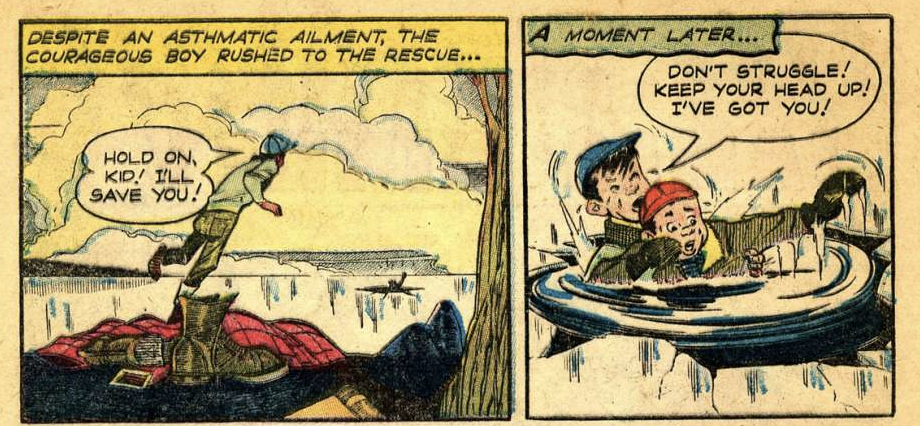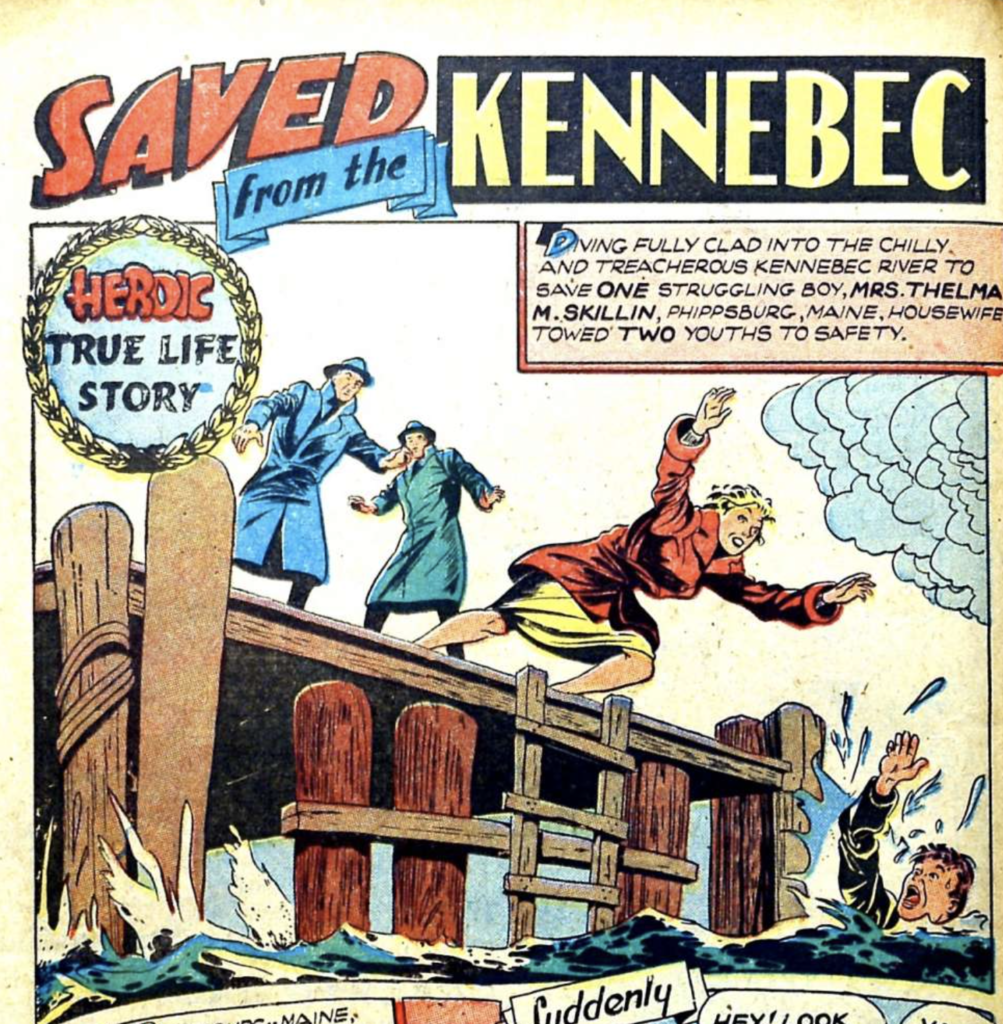
Wham! Pow! Crack! What started as a 1940 comic book series that told true-ish stories of World War II military heroes turned toward civilian heroes in 1946 with Issue No. 35 of The Eastern Color Printing Company’s Heroic Comics (previously Reg’lar Fellers Heroic Comics). In that issue, between the ad for a glow-in-the-dark tie guaranteed to “surprise and thrill every girl you meet,” and a four-page educational spread dedicated to teaching readers everything they need to know about “atomic energy,” there were stories about a switchboard operator who called the police after hearing a nearby murder and a fire fighter who saved a man from a Park Avenue, New York, office building fire.
It was another year before a Carnegie hero was featured among the Good Samaritans. Thelma Marguerite Skillin was the first Carnegie hero to appear in what Eastern Color eventually renamed New Heroic Comics.
“Diving fully clad into the chilly and treacherous Kennebec River to save one struggling boy, Mrs. Thelma M. Skillin, Phippsburg, Maine, housewife, towed two youths to safety,” the first panel stated.
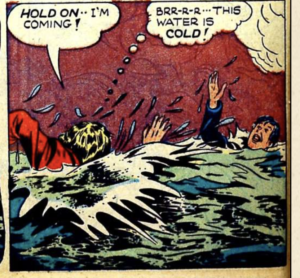
On Nov. 15, 1946, a 14-year-old boy had fallen from a wharf into the river, his feet sticking in silt, 1.5 feet deep. His 18-year-old brother entered the water and freed him, but the panicking boy attempted to climb his brother, causing him to then get stuck in the silt.
Skillin, then 32, housewife, jumped from the wharf and swam to the boys. She took hold of the younger boy under the chin with one hand and towed him 12 feet to a timber projection of the wharf. As the brother tired and began to sink and while still supporting the first boy with the crook of her arm, Skillin grasped the brother by the hair and pulled him to the surface. Others helped them return to the wharf.
Although Skillin’s Carnegie hero paper file has been lost to time, electronic records indicate that she wasn’t nominated until 1948, nearly two years after the act and six months after her story was published in the comic book. “There’s no way for us to know how Mrs. Skillin was nominated all those years ago, but it’s great to see that other people appreciated her bravery and heroism and the tale of her rescue spread far and wide,” said Jewels Phraner, director of outreach and communications for the Hero Fund.
The average distribution of a single issue of a comic published in 1947 was 379,000, according to data collected by the Audit Board of Circulation.
The 1940s are largely considered the Golden Age of comics, which historians chart from the first appearance of Superman in 1938 to 1953, when the U.S. Senate questioned whether comics were responsible for an uptick in juvenile delinquency. Some historians further divide the golden era, calling its latter years the Atomic Age because comic books showed a notable shift from superheroes to other genres: war, westerns, science fiction, horror, and, as New Heroic Comics suggests, non-fiction.
Although comic books were becoming widely popular, with the number of publishers doubling from the decade earlier, readers wanted more realistic stories, according to Matthew Morrison, public services librarian for the Trinity Rivers Library in Fort Worth, Texas.
“Walt Disney Comics were still the highest selling comic of all time during the Golden Age … but we started seeing more things like True Comics, real stories about soldiers, pirates, more military, more true crime, more historical work,” Morrison said.
Eleven other Carnegie heroes were featured in New Heroic Comics from 1947 to 1952.
E. Carver Tettemer — whose story was featured on the cover of Issue No. 45 — saved a 9-year-old boy from being hit by a train in Trenton, New Jersey, after he fell from his tricycle onto the tracks on May 8, 1941.
“Would you jump in front of a train to save another’s life?” starts the two-page spread.
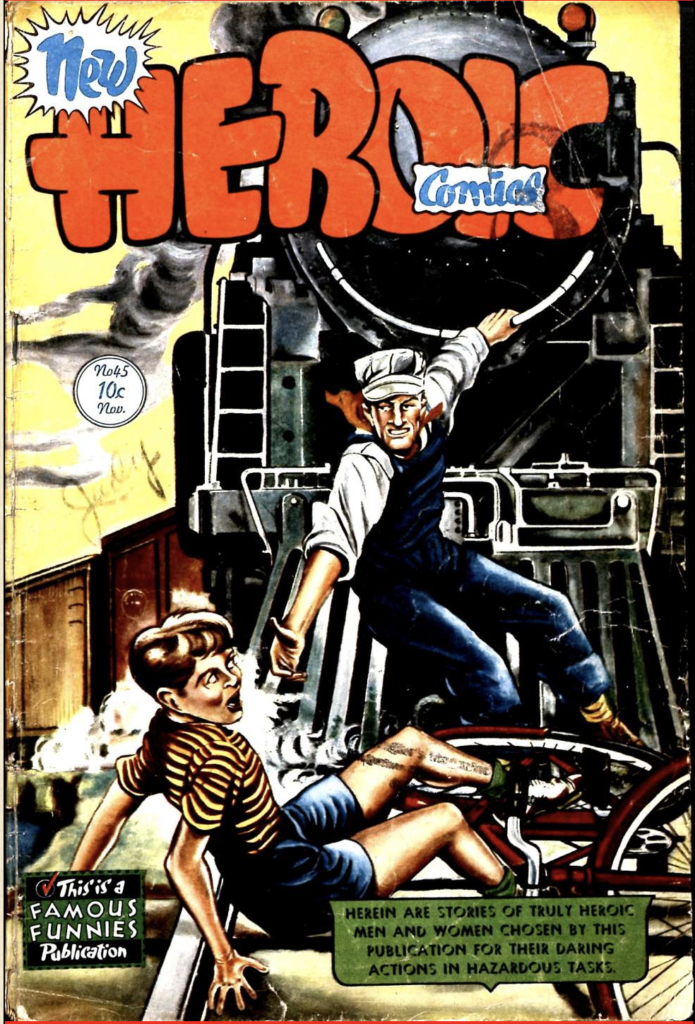
New Heroic Comics Issue No. 49 features two Carnegie heroes. First was Phil O. Garrett’s Jan. 19, 1944, rescue of a man from a fiery plane crash on his Gates, Tennessee, farm. Curiously the story does not mention Garrett’s co-rescuer, Carnegie Hero Robert W. Turner, Sr. It is also the first mention of the Hero Fund, its last panel stating “for his heroic action, Garrett was awarded a bronze medal and a sum of money from a national organization.”
That edition also included a May 27, 1947, technical rescue in which Stanley J. Marcinkowski used a torch to burn an opening in the 1-inch-thick metal hull of a double bottom freighter ship dry-docked in Brooklyn, New York to save a man who had been overcome with smoke at the bottom of the hull. Although the comic mentioned a watch given to him by his employer for a job well done, it fails to mention the Carnegie Medal Marcinkowski received months before the comic’s printing.
The November 1949 edition brings to life the heroism of Robert F. Ramirez. On Oct. 25, 1948, Ramirez dove 40 feet off San Diego’s Sunset Cliffs to recover a 3-year-old boy who had fallen from the cliffs into the Pacific Ocean below. The boy could not be revived. The comic left the ending ambiguous with Ramirez stating “I hope the kid revives …”
Two Carnegie heroes were mentioned in Issue No. 60, published in May 1950. Daniel M. Long is named a “heroic mailman” for jumping into the Charles River in Boston to save a man who had fallen in. In the water the men struggled until Long grabbed the man by the throat and kept him calm. “I’m sorry I have to do this,” Long said in one of the comic’s panels.
Long’s story is notable because it is the first time New Heroic Comics mentions the Hero Fund by name: “For the rescue of a drowning man in the icy waters of the Charles River, mailman Daniel M. Long, of Charleston, Mass., received the Carnegie Medal and award …”
Later in the edition, the Aug. 11, 1949, death of Carnegie Hero June Sickler is called a “supreme sacrifice.” At 15 years old, June attempted to help an 18-year-old man who had fallen into Rancocas Creek in Bridgeboro, New Jersey, but the panicking man submerged her. She drowned.
In this issue Carnegie Hero Virginia Tremblay is also mentioned on the issue’s Heroic Hall of Honor page — used as a kind of table of contents for the heroes mentioned in that edition, but her story doesn’t appear for two more issues.
Tremblay, then 26, saw three boys fall through ice covering Leverett Pond in Brookline, Massachusetts. Leaving her infant with another woman at the scene, Tremblay cross the ice, walking quickly toward the boys. She broke through the ice about 8 feet from the boys and used her arms to break the ice and make a path to them. By the time she reached them, one had submerged, but she held the other two while waiting for help to arrive.
By May 1951, the Hero Fund was making headlines in New Heroic Comics. “Carnegie hero award winner,” topped the story of 14-year-old Arnold J. Davis, who, in February 1949, saved a 13-year-old boy from drowning in the Delaware River in Philadelphia.
The comic book sets the scene: “What better place for a fast and furious game of tag than the pilings of an old wharf? A group of Philadelphia youngsters took full advantage of the Poplar Street wharf to enjoy their sport, when, suddenly …”
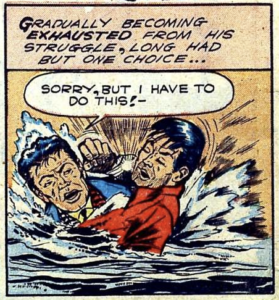
Carnegie Hero Mary Frances Housley’s heroism was the cover story in Issue No. 68. Housley, a flight attendant, forwent her path to a safe exit from a burning airplane that had crash-landed on a Philadelphia runway. Despite being trained to abandon the aircraft when in danger of losing her life, Housley allowed 19 people to exit and maintained her position when others hesitated to leave the plane.
Finally, in Issue No. 70, Samuel F. Sansevere and James J. Kinney were the last Carnegie heroes mentioned by the series. On Feb. 19, 1951, 13-year-old James saved an 8-year-old who had fallen through ice covering Lake Anna in Barbeton, Ohio.
Despite having only one working leg, ship cargo checker Sansevere removed his prosthetic leg and entered the Hudson River in Hoboken, New Jersey, on July 9, 1950, after a longshoreman had fallen in. Pulling the man to the surface and holding him there, he waited for others on shore to lower a ladder and assist both men back onto the ship.
“In every sense of the word, you were a ‘checker’ who checked death!” the last line of the comic reads.
The bi-monthly series ceased publication in June 1955 after the release of Issue No. 97.
